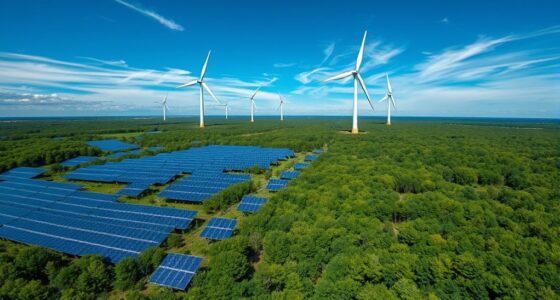Beyond solar panels, there are exciting green tech advances like carbon capture that remove CO₂ from the atmosphere and turn it into useful fuels or store it underground. Algae biofuel offers a sustainable way to produce energy while absorbing CO₂ and thriving on wastewater. Combining these innovations creates a circular system that reduces emissions and generates renewable energy. Stay with us to explore how these futuristic solutions are shaping a greener future.
Key Takeaways
- Advances in carbon capture technology enable the extraction and reuse of CO₂, turning emissions into valuable resources.
- Algae biofuel production leverages fast-growing microorganisms to create sustainable, renewable energy sources with minimal environmental impact.
- Integrating carbon capture with algae cultivation creates a closed-loop system that reduces greenhouse gases while generating biofuel.
- Emerging green tech innovations are expanding beyond solar panels to include new methods for emissions reduction and resource recycling.
- These futuristic solutions promote a circular economy, combining sustainability, scalability, and practical application for a greener future.

While solar panels have become a common solution for renewable energy, innovative green technologies are now pushing the boundaries of sustainability even further. One such breakthrough involves carbon capture, a process that actively extracts carbon dioxide from the atmosphere or industrial emissions before it can contribute to climate change. This technology isn’t just about reducing existing emissions; it’s about turning the challenge of excess CO₂ into an opportunity. By capturing carbon, you can repurpose it in various ways, such as converting it into usable fuels or storing it safely underground. This approach effectively creates a closed-loop system where emissions are minimized and reused, pushing the planet toward a more sustainable future. Carbon utilization is an emerging area that explores creative ways to make use of captured emissions, further enhancing the impact of these technologies.
Alongside carbon capture, algae biofuel presents another promising frontier. Algae are tiny, fast-growing organisms that can produce significant amounts of oil, which can be refined into renewable fuels. You might not realize it, but algae biofuel has the potential to replace traditional fossil fuels in transportation, heating, and even electricity generation. It’s a highly efficient process: algae thrive on wastewater, require minimal land, and absorb carbon dioxide during growth, making them an environmentally friendly resource. By cultivating algae in controlled environments, you can generate biofuel without competing with food crops or degrading land resources. This biofuel can be integrated into existing fuel infrastructure, making it a practical, scalable alternative to conventional energy sources.
Algae biofuel offers a scalable, eco-friendly alternative to fossil fuels by thriving on wastewater and absorbing CO₂ during growth.
What makes these technologies exciting is their potential synergy. Imagine capturing carbon emissions directly from industrial sites and channeling that CO₂ to algae cultivation systems. The algae use the captured carbon to grow rapidly, producing biofuel that can be returned to the energy grid or used in vehicles. This cycle not only reduces greenhouse gases but also provides a renewable energy source, effectively creating a sustainable loop. You might see these innovations as complex, but in reality, they’re practical solutions designed to work hand-in-hand with current systems, making the transition to a greener economy more seamless.
These emerging technologies are more than just futuristic concepts—they’re tangible steps you can support and adopt. They demonstrate that sustainability isn’t just about solar panels or wind turbines; it’s about rethinking how we manage resources, emissions, and energy production altogether. By embracing carbon capture and algae biofuel, you’re contributing to a future where clean energy is abundant, emissions are curbed, and the planet’s health is prioritized for generations to come.
Frequently Asked Questions
How Soon Will These Green Technologies Become Commercially Available?
You’re wondering how soon these green technologies will hit the market. Currently, market readiness varies; some innovations are close to commercial use, while others face technological hurdles like scalability and cost. You can expect early adoption within a few years for certain solutions, but widespread availability might take a decade or more. Staying informed helps you anticipate when these breakthroughs will become accessible and impactful for everyday life.
What Are the Environmental Impacts of Developing These Advanced Technologies?
When developing these advanced green technologies, you’ll want to contemplate their environmental footprint and resource depletion. While they aim to reduce pollution and reliance on fossil fuels, their manufacturing processes can initially increase resource use and waste. However, over time, their widespread adoption can lower overall environmental impacts. You should support innovations that minimize resource depletion and promote sustainable practices to truly benefit the planet.
Are There Any Safety Concerns Associated With Futuristic Green Energy Systems?
Safety concerns with futuristic green energy systems are like charting uncharted waters—you need clear safety protocols and thorough risk assessments. While these innovations promise a cleaner future, their complex nature can pose unforeseen hazards. You should stay informed about safety measures, ensuring proper handling and regulation. By prioritizing safety protocols, you reduce risks, making the journey toward sustainable energy safer for everyone involved.
How Cost-Effective Are These Technologies Compared to Traditional Methods?
When comparing futuristic green technologies to traditional methods, you’ll find the cost comparison is evolving. Many new systems are becoming more economically viable, especially as innovation reduces manufacturing costs. While initial investments might be higher, the long-term savings on energy and maintenance often outweigh those costs. So, you’ll notice these cutting-edge solutions becoming increasingly cost-effective, making them a smart choice for sustainable development and future-proofing your energy needs.
Can These Innovations Be Integrated Into Existing Infrastructure Easily?
Imagine fitting a new, sleek engine into your classic car—it’s possible but often tricky. Similarly, integrating green tech into existing infrastructure faces retrofit challenges like compatibility and grid integration. You might worry about disruption, but with careful planning, these innovations can be seamlessly incorporated, improving efficiency without overhauling entire systems. Advances in smart grid technology are making this process more manageable, ensuring your sustainable future stays on track.
Conclusion
As you explore these cutting-edge green technologies, it’s almost like nature and innovation are working together in perfect harmony. Who would’ve thought that breakthroughs in algae farms or biodegradable batteries would align so seamlessly with our daily lives? Staying ahead means embracing these surprises, realizing that the future of sustainability might just be closer than you think—almost as if the universe conspired to make it happen right when you started paying attention.









